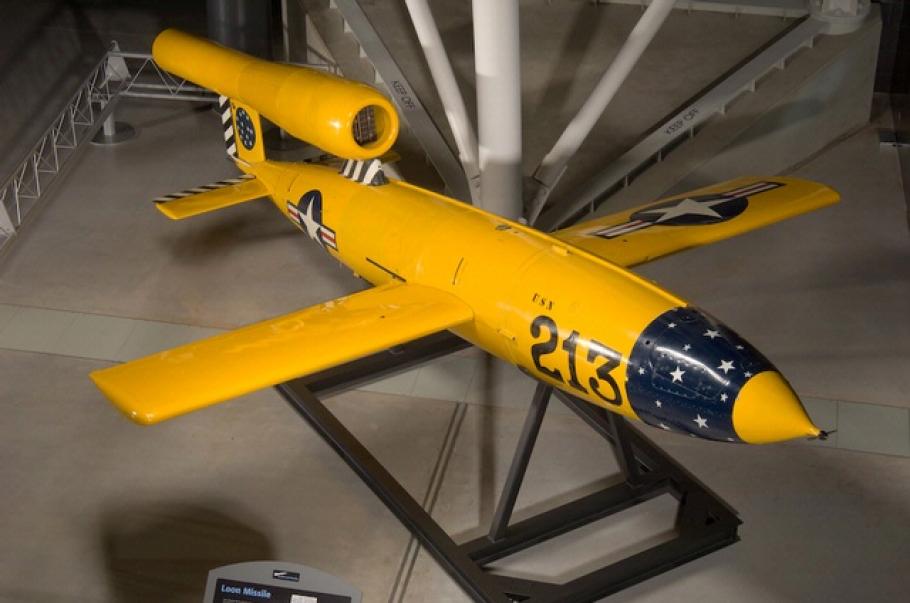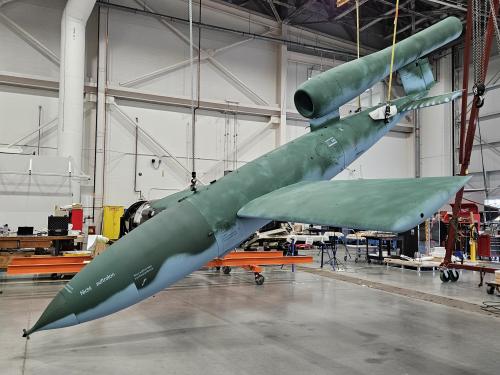
“Buzz Bomb”: 70th Anniversary of the V-1 Campaign
Jun 13, 2014
By Michael Neufeld
On June 13, 1944, exactly one week after the Allied landings in Normandy, Britain came under attack from a strange new Nazi weapon, a flying bomb. The English called it the “buzz bomb” or “doodlebug,” among other nicknames, because its pulsejet engine, based on rapid, intermittent combustion, produced a very loud buzzing sound. Known to its Luftwaffe developers as the Fieseler Fi 103, Hitler’s Propaganda Ministry soon relabeled it Vergeltungswaffe 1 (Vengeance Weapon 1), or V-1. Essentially a small unmanned airplane with an autopilot and a cut-off device, it was what we now call a cruise missile--the world’s first operational cruise missile.
The German V-1 was the world's first operational cruise missile. This one is on display in the Space Race exhibition at the National Air and Space Museum in Washington, DC.
The V-1 came in low, between 1,000 and 3,000 ft., and the effect of its one-ton high-explosive warhead was considerable, causing many deaths and injuries. Soon, as many as a couple hundred per day were launched against London, causing anxiety in the Allied leadership and an exodus of over a million Londoners, mostly children and family members. Prime Minister Winston Churchill even advocated retaliating with poison-gas warfare against German cities, but cooler heads prevailed, and World War II did not turn into a chemical war. By late summer, British air defenses were reorganized with increasing effectiveness, resulting in most being shot down or crashing on the way to the target.
When the Allied armies broke out of Normandy and overran the Channel coast up to Belgium in late August and early September, they captured the catapults used to launch most of them. The attacks from France stopped. But V-1s air-launched by Heinkel He 111 bombers based in the Netherlands kept coming, if in rather smaller numbers. In the fall, the Wehrmacht shifted the V-1 offensive primarily against Belgium, which the Allies had liberated. The northwest European offensive had ground to a halt roughly along the Dutch-Belgian border, due in significant part to Allied logistics problems.
Clearing the Scheldt estuary and opening the large port of Antwerp became critical. Hitler ordered a refocusing of the V-1, and also the new V-2 ballistic missile, on the Belgian port. Launching areas were built up in far northwest Germany and in the Netherlands. Antwerp came under intensive attack, forcing the Allies to deploy American and British anti-aircraft artillery in large numbers to ring the city in defense against the buzz bomb (nothing could be done against the rocket). Antwerp was also the objective of Hitler’s doomed Ardennes offensive, launched December 16, which the Allies called the Battle of the Bulge. When Western forces broke through the Rhine barrier in late March 1945, the V-weapons offensive ended.
Was the V-1 a “wonder weapon”? Not at all. It caused perhaps 10,000 deaths in Belgium and Britain, no small number, but the British and American air forces had learned how to burn down whole cities, causing tens of thousands of dead in a night or two. An old cliché about the new Nazi weapons was that they came “too late” to change the course of the war. In fact they came too early to be in any way decisive. They were too inaccurate--barely able to hit a huge urban area part of the time—and they lacked the blockbuster warhead needed: a nuclear weapon.
The V-1 had an interesting afterlife in the United States. In a rare American example of outright copying, the Army Air Forces and the Navy decided to mass produce a version for the attack on Japan. By the end of 1944, the first copy, which went by the AAF designation JB-2 (Jet Bomb 2) was launched from Eglin Field in Florida out over the Gulf of Mexico. After World War II suddenly ended in August 1945, mass production was stopped, but the U.S. Navy continued to use its version, called the Loon, to gain experience with firing missiles from ships and submarines. It was a precursor to larger, nuclear-armed cruise missiles like the Regulus the Navy deployed in the 1950s.
The Loon, also called the JB-2 or KUW-1, was an American copy of the German pulsejet-powered V-1 or "Buzz Bomb" of World War II. It was designed to carry a 2,200-pound high explosive warhead to a range of 150 miles and could be launched from the ground, ships, or aircraft. It was not used in combat. However, it provided invaluable experience to U.S. Navy and Army Air Force (and later, Air Force) personnel in the handling of missiles.
The Loon, also called the JB-2 or KUW-1, was an American copy of the German pulsejet-powered V-1 or "Buzz Bomb" of World War II. This one is on display at the Udvar-Hazy Center in Chantilly, Virginia.
On exhibit at the National Air and Space Museum are both German and American versions. In the National Mall building is an original German V-1, about which we know little except that it came from Air Force collections of captured Axis weapons. Displayed at the Udvar-Hazy Center is a U.S. Navy Loon in its original test colors. It stands outside the entrance to the McDonnell Space Hangar, in which the Regulus and other U.S. Cold War cruise missiles can be found.
Related Topics
You may also like
Related Objects
We rely on the generous support of donors, sponsors, members, and other benefactors to share the history and impact of aviation and spaceflight, educate the public, and inspire future generations. With your help, we can continue to preserve and safeguard the world’s most comprehensive collection of artifacts representing the great achievements of flight and space exploration.





